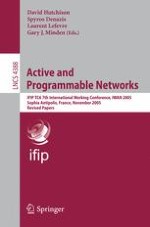This volume contains the proceedings of the 7th International Working Conference on Active and Programmable Networks (IWAN 2005) that was held during November 21–23, 2005, in Sophia Antipolis, Cote d’ Azur, France, jointly organized by Hitachi Europe and INRIA. IWAN 2005 took place against a backdrop of questions about the viability and - cessity of a conference that deals with an area perceived by many as having run its full course. The Organizing Committee, during the preparations of the conference, took these concerns seriously and reflected them in the theme of this year’s event, entitled “Re-incarnating Active Networking Research,” and expanding the scope of past calls for papers into topics that have emerged from active and programmable networks. The result was a success because we received 72 submissions, a number that - ceeded our expectations and in fact is one of the highest in the history of the conf- ence. The distinguished Technical Program Committee set high standards for the final program; each one of the submitted papers received three peer reviews with detailed comments and suggestions for the authors. In total, 13 papers were accepted for the main program sessions with 9 papers accepted unconditionally and the remaining 4 papers being conditionally accepted with shepherding by selected Program Committee members.
